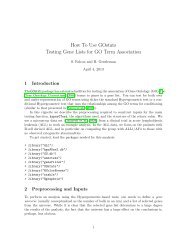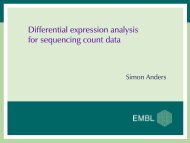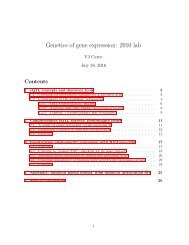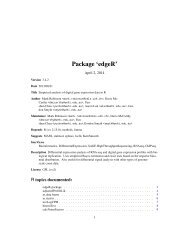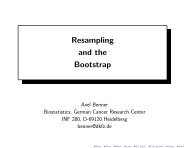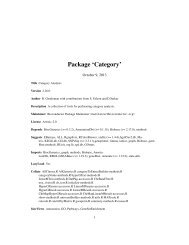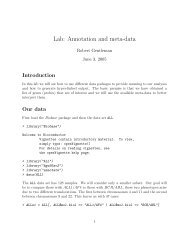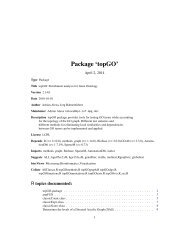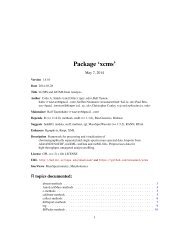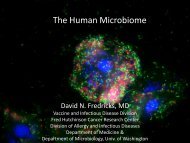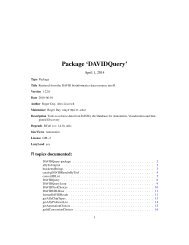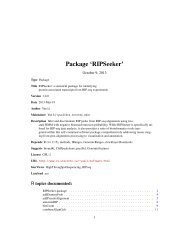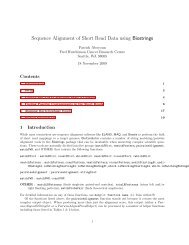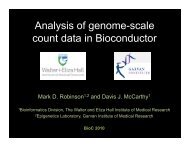Package 'impute' - Bioconductor
Package 'impute' - Bioconductor
Package 'impute' - Bioconductor
You also want an ePaper? Increase the reach of your titles
YUMPU automatically turns print PDFs into web optimized ePapers that Google loves.
<strong>Package</strong> ‘impute’<br />
April 2, 2014<br />
Title impute: Imputation for microarray data<br />
Version 1.36.0<br />
Author Trevor Hastie, Robert Tibshirani, Balasubramanian Narasimhan,Gilbert Chu<br />
Description Imputation for microarray data (currently KNN only)<br />
Maintainer Balasubramanian Narasimhan <br />
Depends R (>= 2.10)<br />
License GPL-2<br />
biocViews Bioinformatics, Microarray<br />
R topics documented:<br />
impute.knn . . . . . . . . . . . . . . . . . . . . . . . . . . . . . . . . . . . . . . . . . 1<br />
khanmiss . . . . . . . . . . . . . . . . . . . . . . . . . . . . . . . . . . . . . . . . . . 4<br />
Index 5<br />
impute.knn<br />
A function to impute missing expression data<br />
Description<br />
A function to impute missing expression data, using nearest neighbor averaging.<br />
Usage<br />
impute.knn(data ,k = 10, rowmax = 0.5, colmax = 0.8, maxp = 1500, rng.seed=362436069)<br />
1
2 impute.knn<br />
Arguments<br />
data<br />
k<br />
rowmax<br />
colmax<br />
maxp<br />
rng.seed<br />
An expression matrix with genes in the rows, samples in the columns<br />
Number of neighbors to be used in the imputation (default=10)<br />
The maximum percent missing data allowed in any row (default 50%). For any<br />
rows with more than rowmax% missing are imputed using the overall mean per<br />
sample.<br />
The maximum percent missing data allowed in any column (default 80%). If<br />
any column has more than colmax% missing data, the program halts and reports<br />
an error.<br />
The largest block of genes imputed using the knn algorithm inside impute.knn<br />
(default 1500); larger blocks are divided by two-means clustering (recursively)<br />
prior to imputation. If maxp=p, only knn imputation is done.<br />
The seed used for the random number generator (default 362436069) for reproducibility.<br />
Details<br />
impute.knn uses k-nearest neighbors in the space of genes to impute missing expression values.<br />
For each gene with missing values, we find the k nearest neighbors using a Euclidean metric, confined<br />
to the columns for which that gene is NOT missing. Each candidate neighbor might be missing<br />
some of the coordinates used to calculate the distance. In this case we average the distance from<br />
the non-missing coordinates. Having found the k nearest neighbors for a gene, we impute the missing<br />
elements by averaging those (non-missing) elements of its neighbors. This can fail if ALL the<br />
neighbors are missing in a particular element. In this case we use the overall column mean for that<br />
block of genes.<br />
Since nearest neighbor imputation costs O(p log(p)) operations per gene, where p is the number<br />
of rows, the computational time can be excessive for large p and a large number of missing rows.<br />
Our strategy is to break blocks with more than maxp genes into two smaller blocks using two-mean<br />
clustering. This is done recursively till all blocks have less than maxp genes. For each block, k-<br />
nearest neighbor imputation is done separately. We have set the default value of maxp to 1500.<br />
Depending on the speed of the machine, and number of samples, this number might be increased.<br />
Making it too small is counter-productive, because the number of two-mean clustering algorithms<br />
will increase.<br />
For reproducibility, this function reseeds the random number generator using the seed provided or<br />
the default seed (362436069).<br />
Value<br />
data<br />
rng.seed<br />
rng.state<br />
the new imputed data matrix<br />
the rng.seed that can be used to reproduce the imputation. This should be saved<br />
by any prudent user if different from the default.<br />
the state of the random number generator, if available, prior to the call to set.seed.<br />
Otherwise, it is NULL. If necessary, this can be used in the calling code to undo<br />
the side-effect of changing the random number generator sequence.
impute.knn 3<br />
Note<br />
A bug in the function knnimp.split was fixed in version 1.18.0. This means that results from<br />
earlier versions may not be exactly reproducible. We apologize for this inconvenience.<br />
Author(s)<br />
Trevor Hastie, Robert Tibshirani, Balasubramanian Narasimhan, and Gilbert Chu<br />
References<br />
Hastie, T., Tibshirani, R., Sherlock, G., Eisen, M., Brown, P. and Botstein, D., Imputing Missing<br />
Data for Gene Expression Arrays, Stanford University Statistics Department Technical report<br />
(1999), http://www-stat.stanford.edu/~hastie/Papers/missing.pdf<br />
Olga Troyanskaya, Michael Cantor, Gavin Sherlock, Pat Brown, Trevor Hastie, Robert Tibshirani,<br />
David Botstein and Russ B. Altman, Missing value estimation methods for DNA microarrays<br />
BIOINFORMATICS Vol. 17 no. 6, 2001 Pages 520-525<br />
See Also<br />
set.seed, save<br />
Examples<br />
data(khanmiss)<br />
khan.expr
4 khanmiss<br />
khanmiss<br />
Khan microarray data with random missing values<br />
Description<br />
Usage<br />
Format<br />
Source<br />
A text file containing the Khan micorarray data with random missing values introduced for illustrative<br />
purposes<br />
data(khanmiss)<br />
The data set khanmiss consists of 2310 rows and 65 columns. Row 1 has the sample labels, Row 2<br />
has the class labels. The remaining rows are gene expression. Column 1 is a dummy gene number.<br />
Column 2 is the gene name. Remaining columns are gene expression.<br />
Please note that this dataset was derived from the original by introducing some random missing<br />
values purely for the purpose of illustration.<br />
Khan, J. and Wei, J.S. and Ringner, M. and Saal, L. and Ladanyi, M. and Westermann, F. and<br />
Berthold, F. and Schwab, M. and Antonescu, C. and Peterson, C. and and Meltzer, P. (2001) Classification<br />
and diagnostic prediction of cancers using gene expression profiling and artificial neural<br />
network. Nature Medicine 7, 673-679.<br />
References<br />
Robert Tibshirani, Trevor Hastie, Balasubramanian Narasimhan, and Gilbert Chu (2002). Diagnosis<br />
of multiple cancer types by shrunken centroids of gene expression PNAS 99: 6567-6572. Available<br />
at www.pnas.org<br />
Examples<br />
data(khanmiss)
Index<br />
∗Topic datasets<br />
khanmiss, 4<br />
∗Topic data<br />
impute.knn, 1<br />
impute.knn, 1<br />
khanmiss, 4<br />
5



